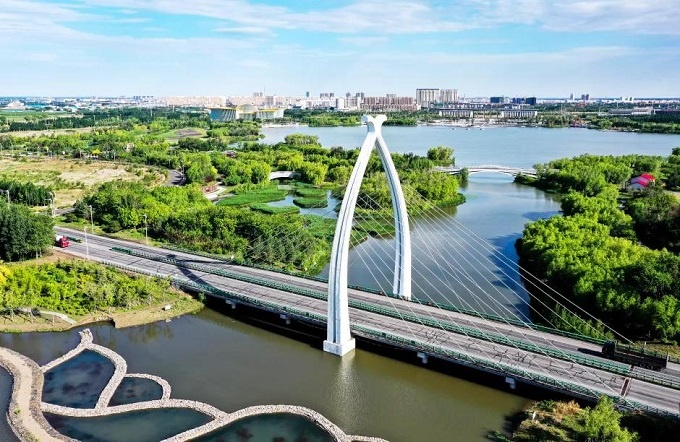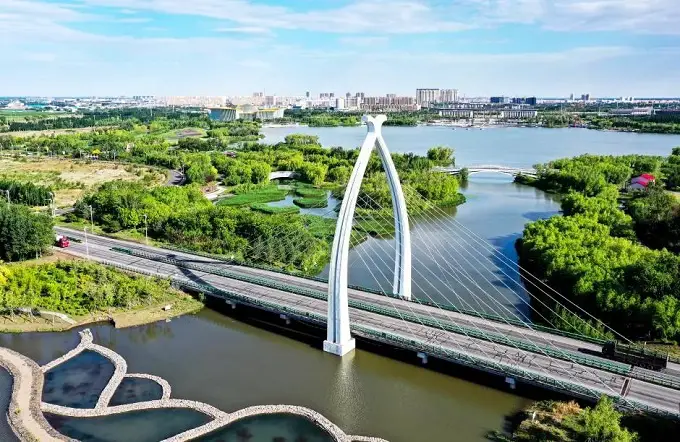By Yue Furong, Zhu Dawei, People's Daily

Photo shows a city view of Baicheng, northeast China's Jilin province. Photo courtesy of the municipal government of Baicheng
Thanks to a major water management project that connects rivers, lakes and ponds, Baicheng of northeast China's Jilin province has been witnessing increasingly improving ecological environment.
The project, initiated in 2013, has connected 124 reservoirs and bogs with pump stations and water channels. It stores the surplus water resources from rivers during flood season in natural bogs and wetlands, so as to expand the city's water area, form a water system and smoothen water circulation.
Baicheng, located in the west of the Nenjiang River Plain, is home to over 700 natural bogs. However, years of droughts had cut off 7 of the city's 8 major rivers since 2000. Besides, the city's wetland area contracted by 40 percent, and 90 percent of the bogs dried up.
Momoge wetland of Baicheng's Zhenlai county had shrunk 70 percent by size, and the number of white cranes having a rest there on their way to the south for winter was once only around 500, said Pan Shengyu, president of a local photography association, who once worried that he would have no bird picture to take once the wetland disappeared.
According to him, Yangsha Bog, a relatively large bog in Zhenlai county, almost dried up before 2010. Pan told the People's Daily that the bottom of the bog had been salinized, and even the wind was sandy.
Fortunately, the water management project has returned favorable ecology to Momoge wetland, where wild ducks are swimming and foraging today in the reeds and bogs on the two sides of the roads there. Besides, the wetland is also frequently visited by gooses.
"I discovered 5 snow gooses recently, which were rare in the past years," Pan said.
At the northeast corner of Zhenlai county, the water of Nenjiang River is pumped up to a main channel, which has an elevation of 8 meters and stretches 50 some kilometers in latitudinal direction in the northern part of the county. The water is transmitted to Yangsha Bog, making it a reservoir that covers over 4,000 hectares, and is also sent to irrigation areas, wetlands and the city through sub-channels. The remained water goes back to Nenjiang River in the southern part of the county.
A total of 73,333 hectares of wetland have been restored or improved in Momoge with the water from the Nenjiang River. In addition, nearly 300 bird species have been resting or breeding there in recent years, including over 3,800 white cranes that stop there for two or three months each year.
The project has restored and improved 640 square kilometers of wetland in Baicheng, recovering 70,000 hectares of grassland and reeds and reducing over 370,000 hectares of desertification land. It has brought a turnaround to the city's vulnerable ecology.
Besides, the project also does a favor for the irrigation of surrounding farmland. Thanks to the project, the maximum underground water level in Baicheng has been lifted 1.02 meters in the city, which has revitalized 15,000 irrigation wells and increased nearly 550 million cubic meters of irrigation water. The coverage of rice fields in the city also went from around 130,000 hectares in 2013 to today's 210,000 hectares. The city also experienced crop harvests in seven consecutive years, and made a name for its quality farm produces.
A research station was established at the Niuxin Taobao Wetland as an effort to explore eco-agriculture, successfully developing a farming mode that breeds crabs in race paddies and reeds. The reed production on this once-alkalized wetland had dropped to 350 tonnes, but now the wetland has turned into a source of income for many local farmers.
Through channel diversion and expansion, the wetland has introduced 35 million cubic meters of water from the Tao'er River nearly 40 kilometers away. This year, a total of 50,000 kilograms of juvenile crabs have been put in the wetland, and the output hit nearly 200,000 kilograms. In addition, the reed production also soared to nearly 10,000 tonnes.
Currently, Niuxin Taobao wetland is planning to expand its "wetland economy". It will develop tourism, underwater farming, as well as reed processing. In addition, it is also working to introduce a technology that cultivates edible fungus in reeds from Chinese Academy of Sciences, and manufacture reed handiworks.
By connecting rivers, lakes and bogs, Baicheng has not only seen improved ecology and environment for living and production, but also created favorable conditions for industrial transformation and green development.
Fishery production of the city stood at 47,200 tonnes last year, hitting a new record in history. This year, the total area of the city's rice-fish fields has reached over 20,000 hectares, which is expected to increase income by 300 million yuan ($45.6 million).
Besides, the sceneries in Baicheng are also attracting tourists from around the country. In the recent two years, the growth of the city's tourism revenue has been kept above 10 percent.
The project, initiated in 2013, has connected 124 reservoirs and bogs with pump stations and water channels. It stores the surplus water resources from rivers during flood season in natural bogs and wetlands, so as to expand the city's water area, form a water system and smoothen water circulation.
Baicheng, located in the west of the Nenjiang River Plain, is home to over 700 natural bogs. However, years of droughts had cut off 7 of the city's 8 major rivers since 2000. Besides, the city's wetland area contracted by 40 percent, and 90 percent of the bogs dried up.
Momoge wetland of Baicheng's Zhenlai county had shrunk 70 percent by size, and the number of white cranes having a rest there on their way to the south for winter was once only around 500, said Pan Shengyu, president of a local photography association, who once worried that he would have no bird picture to take once the wetland disappeared.
According to him, Yangsha Bog, a relatively large bog in Zhenlai county, almost dried up before 2010. Pan told the People's Daily that the bottom of the bog had been salinized, and even the wind was sandy.
Fortunately, the water management project has returned favorable ecology to Momoge wetland, where wild ducks are swimming and foraging today in the reeds and bogs on the two sides of the roads there. Besides, the wetland is also frequently visited by gooses.
"I discovered 5 snow gooses recently, which were rare in the past years," Pan said.
At the northeast corner of Zhenlai county, the water of Nenjiang River is pumped up to a main channel, which has an elevation of 8 meters and stretches 50 some kilometers in latitudinal direction in the northern part of the county. The water is transmitted to Yangsha Bog, making it a reservoir that covers over 4,000 hectares, and is also sent to irrigation areas, wetlands and the city through sub-channels. The remained water goes back to Nenjiang River in the southern part of the county.
A total of 73,333 hectares of wetland have been restored or improved in Momoge with the water from the Nenjiang River. In addition, nearly 300 bird species have been resting or breeding there in recent years, including over 3,800 white cranes that stop there for two or three months each year.
The project has restored and improved 640 square kilometers of wetland in Baicheng, recovering 70,000 hectares of grassland and reeds and reducing over 370,000 hectares of desertification land. It has brought a turnaround to the city's vulnerable ecology.
Besides, the project also does a favor for the irrigation of surrounding farmland. Thanks to the project, the maximum underground water level in Baicheng has been lifted 1.02 meters in the city, which has revitalized 15,000 irrigation wells and increased nearly 550 million cubic meters of irrigation water. The coverage of rice fields in the city also went from around 130,000 hectares in 2013 to today's 210,000 hectares. The city also experienced crop harvests in seven consecutive years, and made a name for its quality farm produces.
A research station was established at the Niuxin Taobao Wetland as an effort to explore eco-agriculture, successfully developing a farming mode that breeds crabs in race paddies and reeds. The reed production on this once-alkalized wetland had dropped to 350 tonnes, but now the wetland has turned into a source of income for many local farmers.
Through channel diversion and expansion, the wetland has introduced 35 million cubic meters of water from the Tao'er River nearly 40 kilometers away. This year, a total of 50,000 kilograms of juvenile crabs have been put in the wetland, and the output hit nearly 200,000 kilograms. In addition, the reed production also soared to nearly 10,000 tonnes.
Currently, Niuxin Taobao wetland is planning to expand its "wetland economy". It will develop tourism, underwater farming, as well as reed processing. In addition, it is also working to introduce a technology that cultivates edible fungus in reeds from Chinese Academy of Sciences, and manufacture reed handiworks.
By connecting rivers, lakes and bogs, Baicheng has not only seen improved ecology and environment for living and production, but also created favorable conditions for industrial transformation and green development.
Fishery production of the city stood at 47,200 tonnes last year, hitting a new record in history. This year, the total area of the city's rice-fish fields has reached over 20,000 hectares, which is expected to increase income by 300 million yuan ($45.6 million).
Besides, the sceneries in Baicheng are also attracting tourists from around the country. In the recent two years, the growth of the city's tourism revenue has been kept above 10 percent.
 Menu
Menu
 Water management project returns sound ecology to city in NE China
Water management project returns sound ecology to city in NE China
















